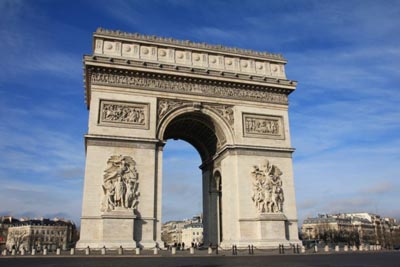
Standing at the centre of the Place Charles de Gaulle, at the western end of the Champs-Élysées in Paris, the Arc de Triomphe, is perhaps the most artistic and monumental of all the triumphal arches in the world. Built between 1806 and 1836, it is also known as the Place de l'Étoile, the ‘star’ of the junction, formed by its twelve radiating avenues. The magnificent Arc de Triomphe is considered to be the keystone of the historic axis (L'Axe historique), a series of monuments and grand thoroughfares on a long route running from the courtyard of the Louvre Museum to the Grande Arche de la Défense, the modern business district of Paris.



Inspired by the Roman Arch of Titus, the Arc de Triomphe, designed by Jean Chalgrin in 1806, was inaugurated in 1836 by the French king, Louis-Philippe I, who dedicated it to the armies of the Revolution and the Empire. Engraved on the inside and at the top of the arch are all of the names of the generals and the wars fought. Apart from that, there is an underground vault, which houses the Tomb of the Unknown Soldier from World War I, where the Memorial Flame burns in memory of the dead soldiers, who were never identified.

The majestic structure of Arc de Triomphe has an imposing height of 50 m, width of 45 m and a depth of 22 m. Till the completion of the Monumento a la Revolution in Mexico City in 1938, it was the tallest triumphal arch in the world.
There are four main sculptural groups on each of the Arc's pillars - Le Départ de 1792, Le Triomphe de1810, La Résistance de 1814 and finally, La Paix de 1815.

Le Départ de 1792 (departure of the Volunteers of 1792), commonly called La Marseillaise 1792 and created by Francois Rude, is considered as a masterpiece. In a romantic style, it depicts the historical event of the commitment of the national volunteers against the armies of the first coalition in 1792. The volunteers are leaded and encouraged by a winged figure, allegory of victory. The wife of the artist, Sophia Rude, posed for the face of the allegorical figure. On the lower part of the relief, helmeted and armed soldiers of all ages are represented either naked or bare-chested or dressed in the Gallic costume.

The Treaty of Schonbrunn, also known as the Treaty of Vienna, signed between France and Austria, is depicted in Le Triomphe de1810, by Jean-Pierre Cortol. It features Emperor Napoleon I being crowned with a wreath by the allegorical female figure of the Goddess of Victory, for his decisive win against Austria at the Battle of Wagram.
The lower section of the southwest pillar of the Arc de Triompe, facing Avenue de la Grande Armeé, is adorned with La Résistance de 1814, by Antoine Etex, which commemorates the French resistance to the Allied armies during the War of the Sixth Coalition.

La Paix de 1815, also by Antoine Etex was designed as an allegory to represent the Treaty of Paris in 1815, which was signed on 20 November 1815 following the defeat and the second abdication of Napoleon Bonaparte. It features a soldier returns his sword, a mother holds her child, a man examines a plow. Above them stands Minerva, the Roman goddess of war and wisdom, leaning on an olive tree and a spear. It was created in a style referred to as a high relief, making it look more like an actual statue.

Like the pillars, the façades of the Arch are also adorned with six sculpted reliefs, representing some of the important moments of the French Revolution and of the Napoleonic period. A list of French victories is also engraved under the great arches on the inside façades of the monument, while the attic bears the names of some great battles of the French Revolution and Napoleonic Wars.

The Arc de Triomphe has witnessed many historical events. Bought back to France from St. Helena, the remains of Napoleon passed under it on 15 December 1840, on the way to the Emperor's final resting place at the Invalids. The body of Victor Hugo, prior to burial in the Pantheon, was displayed under the Arc during the night of 22 May 1885. After successful military campaigns and for the annual Bastille Day Military Parade, It became the rallying point of the French troops. The famous historical victory parades that marched around or under the Arc include the Germans in 1871 and 1940, the French in 1919, and the French and Allies in 1944 and 1945. However, subsequently all military parades have avoided marching through the actual arch, out of respect for the tomb of the Unknown Soldier and its symbolism. All parades took the route up to the arch and then around its side. Both Hitler in 1940 and de Gaulle in 1944 observed this custom.
By the early 1960s, the monument had grown much blackened from coal soot and automobile exhaust. However, it was cleaned during 1965 -1966 through bleaching. Conceived by the artist Maurice Benayoun and the architect Christophe Girault, a permanent exhibition opened inside the monument in February 2007.